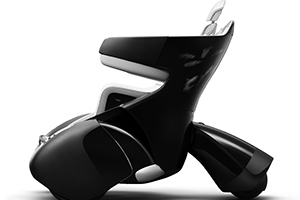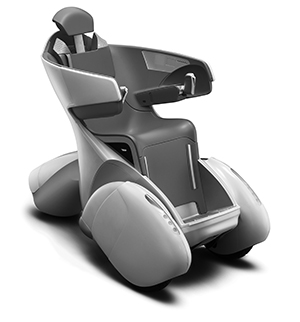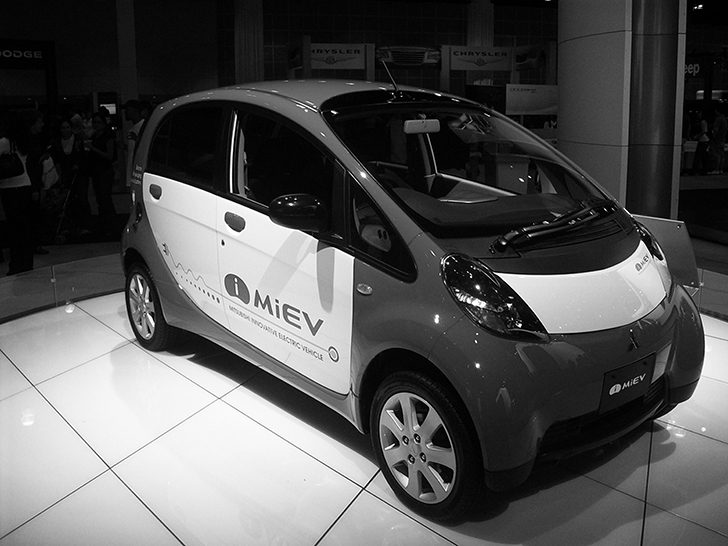 It’s almost midnight and by rights you should be curled up on the sofa in pre-bed chillout mode, watching nonsense on Fox. Instead you’re still at work. You’ve just got out of a weekly conference call with HQ in London and being that it’s HQ, GMT always trumps EST, as antisocial as this makes all your Wednesday evenings. Half asleep you ride the elevator to the basement whilst languidly fumbling in vain in your pockets for the miniature device with the silver ‘N’ embellished on it that you’ve left on your desk. Three minutes later and the device is scanning your fingerprint and your Nissan Pivo 2 rolls silently around the corner, stops in front of you and opens its front end in a grandiose sweeping gesture that at once welcomes and beckons you into its bubble-like interior.
It’s almost midnight and by rights you should be curled up on the sofa in pre-bed chillout mode, watching nonsense on Fox. Instead you’re still at work. You’ve just got out of a weekly conference call with HQ in London and being that it’s HQ, GMT always trumps EST, as antisocial as this makes all your Wednesday evenings. Half asleep you ride the elevator to the basement whilst languidly fumbling in vain in your pockets for the miniature device with the silver ‘N’ embellished on it that you’ve left on your desk. Three minutes later and the device is scanning your fingerprint and your Nissan Pivo 2 rolls silently around the corner, stops in front of you and opens its front end in a grandiose sweeping gesture that at once welcomes and beckons you into its bubble-like interior.
“Good morning sir and how was your day yesterday?” asks the dashboard-mounted computer with perhaps just a tad too much emphasis on time frames and their technically perfect corresponding grammatical tenses.
“No small talk tonight, err, sorry this morning, please, after all despite the fact that your manufacturers did design you with a face, of sorts, and yes it is cute because this is Japan, you are in fact a computer and I do feel a trifle odd about having a yarn with you… Plus we’ve only known each other for a few weeks… Look it’s nothing personal… It’s not you it’s me… Navigation please. Home. Auto.”
“I shouldn’t have to justify my reasons for not wanting to talk to a talking dashboard,” you try guiltily to convince yourself. “After all Pivo-chan was only trying to be nice, I’ve heard some people’s dashboards don’t even make the effort.”
With no further pleasantries the cabin rotates 360 degrees on a central axis as the wheels remain in place (easy solution to those pesky three-point turns) and drives itself up the exit ramp and merges effortlessly, inaudibly and emissionlessly with Tokyo’s twilight traffic—its unconscious cargo reclining comfortably within a womb-like carbon fiber mold, in the capable, fully-automated hands of the intelligent ‘by wire driver’.
DRIVING OUT RECESSION
Honda, Toyota, Mitsubishi, Nissan, in fact all of the eight recognizable Japanese automakers have urban concepts similar to the Pivo series, with names like: RiN and i-Real (Toyota), Puyo (Honda), i-MiEV (Mitsubishi), the names alone connote cartoonish, micro-electronic wizardry and all-round Japanese gadgetry. They are more personal transportation devices, than cars, and all sport plug-in electrical capabilities, fuel cells, or ultra efficient and super-clean hybrid powertrain solutions that, depending on the concept’s designer, are either hidden or revealed by uber-modern, composite exteriors – some of which shape-shift to wrap around your body like a Steve Job and Tom Ford reinvention of the electric wheelchair.
Others, somewhat unfathomably change color depending on the driver’s mood (perhaps no further need for the antiquated horn then – when you see a pulsating red orb in your rear view mirror, this should be reason enough to give way or risk the wrath of the driver’s rage).
However, most of these machines are merely one-off utopian gimmicks to be showcased by Japanese designers flexing their globally unrivaled muscles of innovation to the world and in doing so securing more fiscal support for future research and development of yet more whacky, extraneous concept cars – also having the media hail them as environmentally conscious technical pioneers doesn’t hurt their all-important global PR and CSR images either.
Japanese car manufacturers have always invested heavily in research and development and were actually infatuated with energy efficiency long before global warming was accepted as a worldwide reality. For decades Japanese companies have struggled to cope with their oil-poor country’s sky-high energy costs by placing a premium on energy-saving technologies and, coupled with the western world’s decree to break the shackles of its middle-eastern oil addiction and turn instead to sustainable domestic forms of ‘new energy,’ the Japanese penchant for frugality and innovation could just pay off. Big time.
Tomomitsu Uemoto, a spokesperson for Japan’s Ministry of Land, Infrastructure, Transport and Tourism, certainly seems to thinks so. He believes that automakers in Japan may not just be paving the way for a cleaner, greener future, but that their next generation of hybrid cars could indeed lead the country out of its crippling recession, as he explains.
“The Japanese economy relies heavily on developing and exporting electronic goods and cars,” says Uemoto. “In Japan at the moment people aren’t buying new cars and because of the exchange rate and the global economic turndown, production and export of Japanese cars are at an all time low.
Most Japanese car manufacturers have been forced to shut down some of their assembly lines in their factories and restructure their workforces. The situation facing manufacturers in America is even more serious. However, although the short-term view for Japanese automakers, particularly for this fiscal year ending March 31 2009, is a little depressing, the market will recover and when it does international and domestic consumers will be more concerned with economy and environment than with status and power – when this happens Japanese car manufacturers are perfectly placed with the history, technology and manufacturing infrastructure to capitalize and reverse the effects of the Japanese recession.”
CROSSBREEDS AND THOROUGHBREDS
 General Motors, Chrysler and Ford, also known as the ‘Detroit Big Three,’ since going to the US Government with caps in hand for multi-billion dollar bailouts, have caused irreparable damage to their own public image, being that it’s the American public who will inevitably have to pick up the slack through tax hikes, or through money earmarked for other public/social indispensables being redirected andrerouted directly to Detroit.
General Motors, Chrysler and Ford, also known as the ‘Detroit Big Three,’ since going to the US Government with caps in hand for multi-billion dollar bailouts, have caused irreparable damage to their own public image, being that it’s the American public who will inevitably have to pick up the slack through tax hikes, or through money earmarked for other public/social indispensables being redirected andrerouted directly to Detroit.
Couple this with the fact that the Big Three are commonly associated with the mass production of ‘All American,’ thoroughbred, gas-guzzling, oil-reliant, carbon-oozing SUVs, or the cars of here and now, to put it more accurately and when the world stops reeling from recession, it should come as no surprise that consumers will be looking for cheaper, more fuel-efficient/environmentally-more-friendly alternatives to the vehicular varmints Detroit tends to churn out.
Yes, Honda has cut its full-year profit forecast by almost 60 percent, and yes Nissan (and particularly Toyota, who recently recorded losses of $4.17 billion), are having to tighten their (seat) belts, but these companies have been poised for the inevitable switch to environmentally-more-friendly cars for a long time. After all, the idea for an electric-powered car has been around since the days of Thomas Edison, it’s only ever been a question of technology and demand—the former of which is abundant and the latter is rapidly growing.
Toyota launched the G21 Project, which ultimately gave birth to the (now) popular Prius. The Prius which debuted on the roads of Japan in 1997 is the first ever mass-produced hybrid vehicle and is powered by a regular gasoline engine and a permanent magnet AC electric motor and nickel-metal hydride battery pack. According to the United States Environmental Protection Agency, the 2008 Prius is the most fuel-efficient car sold in the US. The UK’s Department for Transport also posted similar reports.
Toyota, having filed more than one thousand new patents on this model alone, debuted its all-new 2010 Prius last year at the North American International Auto Show, the new model is expected to go on sale globally this spring and by 2010 Toyota aims to be selling 400,000 units annually and a million in the two years following. Irv Miller, Toyota’s Vice President of Environmental Affairs, despite Toyota’s well-publicized record losses, announced earlier this year that Prius PHVs (plug-in hybrid vehicles) powered by lithium-ion batteries will be available for fleet buyers beginning in late 2009 and the general release has been slated for 2011, heralding yet another dimension of this new era of greener cars.
Although the mass production of fuel cell technology is still financially prohibitive, it’s logical to conclude that the hybrid market will, this year, defy the stifling gravity of the recession. In addition to Toyota’s Third Generation Prius and the return of Honda’s hybrid Insight—both of which are high-volume, well-priced options for mainstream car buyers—high-end newcomers Mercedes and BMW will also be launching their luxury vehicles with cross-bred powertrains under their hoods. Greek mythology’s Chimera would be so proud.
Despite tough economic times and a rapidly shrinking US market, demand for hybrids continues to outpace the overall market and hybrid sales as a percentage of all new car sales are likely to expand from about 2.5 percent in 2008, to upwards of 3 percent this year. Such projections made over a slightly longer term and taking into consideration hybrid purchasing incentives like bigger tax breaks (as promised by the Obama administration, with similar incentives likely to follow in Japan), as well as government subsidies to automakers to further stimulate and encourage development (again Obama’s earmarked billions for the development of sustainable ‘new energy’), and these figures could mushroom into something positive.
BATTERIES INCLUDED
Perhaps the biggest signs that Japan, as a nation, is one-step ahead of its counterparts in accepting the fact that cleaner, greener cars will become a worldwide norm is the way in which Japanese automakers have aligned themselves with electrical companies. Specifically, those that make batteries. Also, the way Japanese society in general readily and rapidly embraces and adopts technical innovation and paradigm shifts into everyday life is a strong positive for the industry.
The key to Japanese automakers protecting their edge when it comes to green car projects (in light of the fact that hybrid technology is old news) is joining forces with makers of electronics and batteries. Toyota’s joint venture with Panasonic (which is actually majority-owned by the car maker) has already made it one of the world’s leading battery companies. Similarly, Nissan recently increased its stake in its own battery collaboration with NEC, investing in a new, gargantuan factory with the express aim of marketing its lithium-ion batteries to other carmakers. The future for cars, it would appear, is a battery-operated one.
Japan is decades ahead when it comes to the development of new energy sources and their practical applications in society, and as such Japanese society will be the first to benefit and double-up as a living showcase of its own innovative achievements. Fuel cell production will become cheaper, that’s just how the cycle goes. New technologies are always expensive to produce at first, but rarely do things stay this way. Such is the confidence in this technology, following its demonstrable benefits to the automotive industry, that a recent statement from Nippon Oil to the Nikkei said it plans to “begin full-scale sales of home-use fuel cell systems in the year ending March 31, 2010.”
So in a year or two—and let’s not take this lightly—we will quite likely be living in a society that opts to light and heat its houses, water and cook its food by essentially using air (hydrogen) which we have in abundance. Via a simple reaction using anodes, cathodes and catalysts (it’s moderately more technical than that), electricity is created. The by-product of the process, far from increasing the size of an individual’s or society’s carbon footprint, goes some way towards washing it away. It’s water. Good ‘ol H2O, or o-mizu, as it’s commonly known here. As our electricity bills and collective guilty environmental conscience are drastically reduced, the world will look on, green with envy and quickly import the new technology for itself—further galvanizing Japan’s (soon-to-be-renewed) economic prowess.
Story by Jon Day
From J SELECT Magazine, April 2009










-360x230.jpg)




Recent Comments